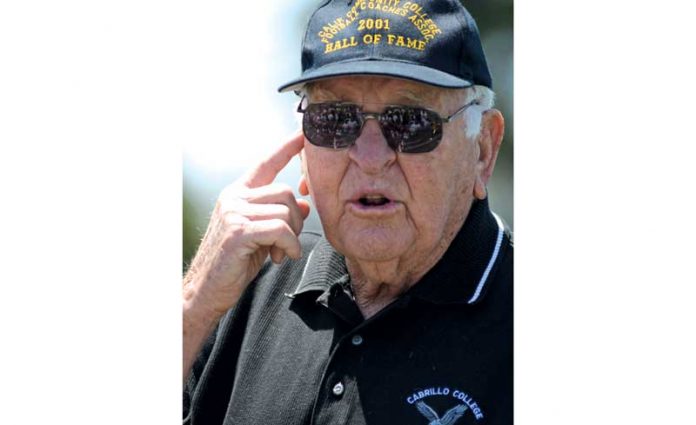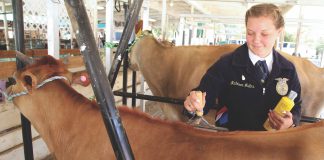WATSONVILLE–Gene Johnson, who coached nearly six decades in Santa Cruz County, died Jan. 14, two days shy of his 95th birthday.
He spent the last year and a half at Valley Convalescent Hospital in Watsonville with his wife, Doris, where they celebrated their 73rd anniversary at the nursing home. Johnson is survived by his son, Robert, daughter, Jill Carolan, and five grandchildren.
Johnson, a World War II veteran, spent 57 years in the county as a coach for several sports programs, starting with a gig as the junior varsity coach at Watsonville High. He made the jump from high school over to Cabrillo College in Aptos as a football assistant coach from 1968-2005 and the school’s head softball coach from 2003-11.
“Sports has always been a big part of my life,” Johnson said in his induction video for the Cabrillo College Hall of Fame. “I credited that with me staying in school. I wasn’t the greatest student, but I wanted to play football, basketball and baseball.”
Johnson was inducted into Watsonville High’s Hall of Fame, California Community College Football Coaches Association Hall of Fame in 2010 and Cabrillo’s Athletics Hall of Fame in 2016.
He attended Fremont High School in Sunnyvale but he failed to complete his senior year, quitting school and joining the Navy as soon as he turned 18. Johnson served three years, including some time in the Atlantic and South Pacific.
After the war, he used the GI Bill money to pay for his education at San Jose State University, where he graduated in 1950 with a degree in physical education. He earned a master’s degree from Stanford University in physical education in ’51.
He also played semi-pro football for a couple of years in Mountain View and San Jose.
His first teaching job was at Williams High in Williams, where he coached football, basketball and baseball. Two years later, he landed a job at Washington High in Fremont where he also coached football and baseball.
Johnson brought the Huskies baseball team to play at Watsonville High, which got in touch with him a day later to offer a teaching job and football coaching position.
In 1955, he coached a junior-varsity team that went 10-0 in his first season. He then replaced the legendary Emmett Geiser as varsity head coach the following season and was at the helm for 13 seasons (1956-67).
Former Watsonville High football head coach Ron Myers first met Johnson in the ‘80s when they were on the same teaching staff for four years.
During his first year of spring practice, Myers was chatting with Johnson and he volunteered to help coach the defensive backs, which was his expertise.
“So he shows up and he brings Sherman Cocroft with him,” Myers said. “That’s when he was playing in the NFL. So, he’s doing the drills and it kind of got the guys’ attention.”
Myers learned a lot and the one thing he remembers is how Johnson got the players to work continually without any hold ups in the practice lines. It’s moments like those that had a profound impact on Myers.
“The first word that comes to my mind is steady,” he said. “One of the most consistent men I’ve ever met. His temperament, the way he approached life, he was just steady. He had a consistent godliness about him that was just always there.”
Johnson continued his coaching career at Cabrillo College under head coach Hal Mitchell, who was a former UCLA and New York Giants player as well as a coach at BYU.
“[Mitchell] was impressed with some of the players that played for me that came to Cabrillo and said he’d like to have me on his staff,” Johnson said during his hall of fame induction speech. “I jumped at the chance, it was a chance to do something different and I took it.”
Johnson spent the next 35 years with the Seahawks, helping them win the first of several championships under head coach Joe Marvin in 1972. Johnson also served under Steve Cox, who posted a four-year title run in the late ’90s and won two more titles in the 2000s.
Johnson said he considers the championship years as some his best moments in his career, but he also highlighted being able to coach outstanding players in his time that included All-Americans and professionals.
“That was a thrill to watch them at the next level,” Johnson said.
NFL players in his time with the Seahawks included Sherman Cocroft, Sam Kennedy, Brendon and Obafemi Ayanbadejo, Reggie Stephens and Dwight Lowery.
Cocroft, a Watsonville High and Cabrillo alumnus, was picking artichokes in Castroville when Johnson approached him, suggesting that instead he should be playing football. The coach kept trying to recruit the student until finally Cocroft gave in.
One of his fondest memories of Johnson was when he reached out to his mom, Gwendolyn, and how the two of them had conversations about keeping him in school. Cocroft knew deep down inside that this football coach cared about him and the rest was history.
“He took the time, always, to set me aside and teach me how to be a leader,” he said. “He always taught me the only way you’re gonna play well is you have to be coachable. And I know you’re coachable because I have your mom’s number.”
Cocroft, who went undrafted and signed with the Kansas City Chiefs in 1985, will always remember how Johnson had the gift of letting players know what went wrong and then encourage them to do better the next time.
The former defensive back would invite Johnson to his yearly 7-on-7 camps he held at Cabrillo, hoping the old school coach would inspire the next generation of football players.
“The way that he would talk to you, coach you, encourage and inspire you, that was part of the biggest effect,” Cocroft said.
In 2003, Johnson saved the softball program from being eliminated when he was asked by former athletic director Dale Murray to take over for a season. He stuck around for nine years and led the Seahawks to the state playoffs twice during his stint.
Kristy (Ballinger) Rosinger, who was a former former player and assistant under Johnson, replaced him as the skipper after he stepped away from the program at the age of 86.
After he retired from coaching, Johnson still spent a lot of his time at Cabrillo to watch the action on the field or on the court.
“It’s fun to watch as a spectator, kind of frustrating sometimes when you see things that need to be done but you’re in the position to interfere, you have to keep your mouth shut,” he said. “But overall, it’s been a pleasure.”













